Kalapalo
- Self-denomination
- Where they are How many
- MT 855 (Siasi/Sesai, 2020)
- Linguistic family
- Karib
Village life among the Kalapalo – one of the Karib-speaking groups in the Upper Xingu region – varies according to the seasons. During the dry season, which lasts from May to September, food is abundant and public rituals take place, which usually involve a great deal of music and the participation of members from other villages. During the rainy season, food becomes scarce and village relations are confined to those between households and relatives. In the multiethnic context of the Indigenous Park of the Xingu, the Kalapalo have played a prominent role in actively patrolling its borders, preventing the invasion of neighboring cattle ranchers.
Language
The Kalapalo and three other Upper Xingu groups – the Kuikuro, Matipu, and Nahukuá – speak dialects of a language belonging to the Southern Guiana branch of the Karib language family. Their closest linguistic relatives are the Yekuana (Makiritare) and the Hixkaryana, the former found in southern Venezuela and northern Roraima (Brazil), the latter in northern Pará (Brazil).
Contact history
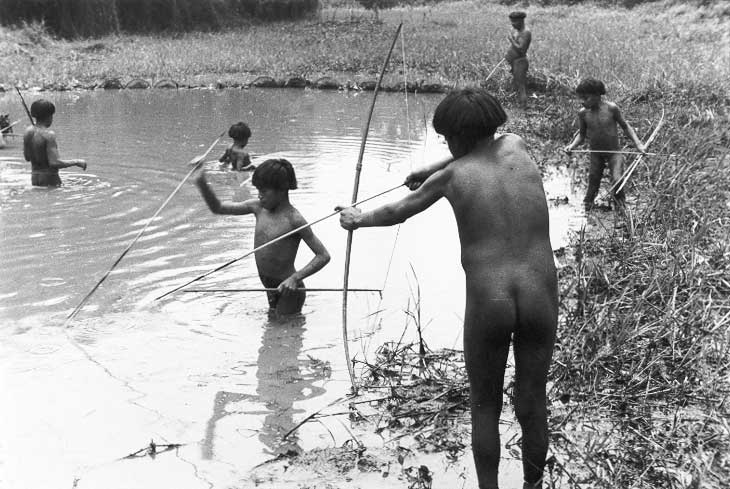
A few similarities between Kalapalo and Yekuana myths suggest that the ancestors of the Xingu Karib groups left the Guiana region in recent times, certainly after contacts with Spaniards intensified in the region in the latter half of the eighteenth century. Nonetheless, there seems to be little in common culturally between the Kalapalo and these northern Karib speakers, and it is difficult to distinguish any prominently characteristic “Karib” aspects of their way of life or world view.
It is uncertain when the group known as Kalapalo was first contacted by outsiders. Individuals identified with the settlement of their name were measured by the German anthropologist Hermann Meyer during an anthropometric study of Upper Xingu peoples at the end of the nineteenth century. In 1920, Major Ramiro Noronha of the Rondon Commission surveyed the Kuluene River and made the first recorded visit to the Kalapalo, Kuikuru, and Anagafïtï (in the literature, “Naravute”) settlements. The latter in particular were to suffer in consequence of this visit, after which the first of a series of epidemics destroyed the integrity of their community.

The name “Kalapalo,” initially applied to this group by non-Indians, refers to the name of a settlement abandoned perhaps no more than a hundred years ago. About that time, people moved from Kalapalo to a neighboring site called Kwapïgï, which in turn was succeeded by the settlement called Kanugijafïtï, abandoned in 1961. All these sites are located about a half day’s walk east of the Kuluene River, south of the confluence with the Tanguro. The last remnants of an important Karib-speaking group called Anagafïtï joined the people of Kanugijafïtï after the flu epidemics of the 1940s, and there were Kuikuru, Mehinaku, Kamayura, and Waura living among the Kalapalo by then.
What we now call “Kalapalo,” then, is a community consisting of people whose ancestors were associated with several different communities, with a majority having come from, or descended from persons who lived at, Kanugijafïtï.
Location

Today, the Kalapalo live in eight settlements Aiha (meaning “finished” or “ready”), Tanguro, Agata, Caramujo, Kunue, Lago Azul and Kaluane, all in the Kuluene river and its tributaries, and one settlement in the southeastern border of the Xingu Indigenous Park. Besides these villages, some Kalapalo live at the Tanguro and Kuluene Indigenous Security Posts (PIV). Each of these Posts is located on the river whose name it bears, on points along the border of the reservation.
The former villages of the Kalapalo were located to the south, on both sides of the Kuluene River. The Kalapalo moved reluctantly to their current location after the boundaries of the Xingu Reservation were formally established in 1961, when outlying groups were encouraged to move closer to the Leonardo Indigenous Post in order to control contact with outsiders and to provide medical aid in the event of epidemics.
Nevertheless, they have continued to return to their traditional territory, harvesting pequi fruits from the extensive groves still found around the old settlements, searching for land snails from which they manufacture shell ornaments (a specialty of their group), and to fish and plant fields of manioc, sweet potatoes, and cotton at several places along the Kuluene River.
However, many of the pequi groves were left outside the reservation borders and were d estroyed by cattle ranchers. At this time, the Kalapalo, along with Funai, are demanding the return of part of this territory, in the land occupied by the current Sayonara ranch. Kalapalo representatives have also actively participated in the Borders Project, coordinated by ATIX (the Xingu Indigenous Lands Association), by patrolling the reservation boundaries and organizing frequent expeditions to inspect the boundary lines and keep them clear of overgrowth.
Population
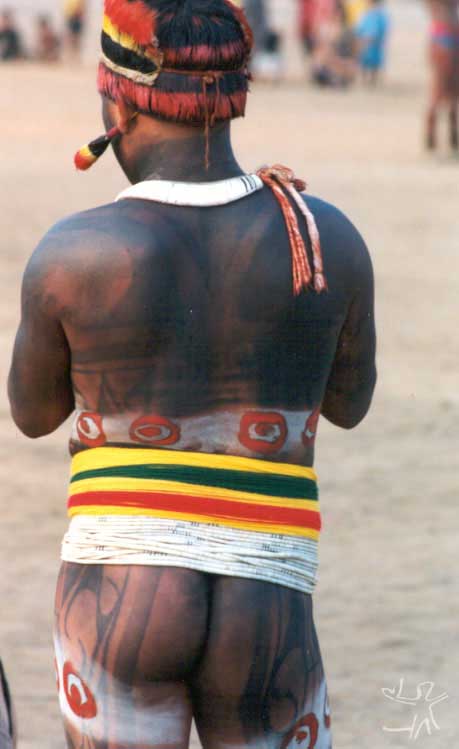
Because of epidemics of measles and influenza during the twentieth century, the population of the Kalapalo greatly diminished, and it was not until the 1970s that it began to recover. In 1968, they numbered 110 persons living in six houses, but by 1982, they had increased to 185 persons living in thirteen houses. In 1999, the population of the Kalapalo villages was estimated to be approximately 362.
The present Kalapalo population includes descendants of an important Karib group, called Anagafïtï, who joined them after a flu epidemic in the 1940s. People from other ethnic groups – the Kuikuru, Matipu, Nahuquá, Mehinaku, Kamayura, and Waura – also live in their villages, due to intermarriages with the Kalapalo.
Social organization

Kalapalo social organization is extremely flexible, with considerable variation in the identification of individuals with specific groups. Kalapalo may often have several options for joining groups, their choices being dependant upon the personal relationships between individuals rather than upon such considerations as clan membership, religious affiliation, or ancestral rights and obligations. The elaborate system of relationship terminology seems to accommodate this flexibility and to provide a means for specifying in precise detail the actual relationship between individuals in both a social and psychological sense.
Both the settlement and the household acts as a unit when performing economic and ceremonial activities. Thus, the inhabitants of each village clear land for manioc fields, harvest arrow cane, collect wild fruits and other plant materials, and exploit aquatic resources of the region’s lakes and streams. Members of other settlements do not exploit Kalapalo territory, unless they are living temporarily with them and have been explicitly invited to do so.
Similarly, members of a household group are obliged to distribute food among themselves. Although every adult is responsible for contributing continuously to the food supply, a Kalapalo is assured of a share even when he or she does not, or cannot, contribute. However, the obligation to share food is not extended to include the membership as a whole of other households, and it is considered impolite to exploit the goodwill of persons outside one’s own group who are under no obligation to provide one with food. Despite this corporate organization, membership in settlements and households shifts from time to time, and there is occasional movement of some persons from group to group.
Norms and behavior
Central to the discussion of human social life is an ideal of behavior called , a set of ethical statements by which the Kalapalo distinguish Upper Xingu people from all other human beings. In a more general sense, can be defined as behavior characterized by a lack of public aggressiveness – for example, avoiding arguing in public and not provoking situations that will make others uncomfortable – and by the practice of generosity – such as hospitality and the willingness to give or share material possessions. The Kalapalo believe that their society’s viability depends upon conforming to this ideal.
The concept of extends into virtually every area of social life, applying in varying degrees to relationships among local groups, kinspeople, relatives by marriage, men and women, and even between humans and non-humans. Similarly, the demonstration of behavior confers prestige and therefore is important in the allocation of political power. This ideal is manifested in a distinctive behavioral and conceptual complex that the Kalapalo claim distinguishes them from their traditional neighbors.
Before the establishment of the reservation boundaries and permanent contact with Brazilians, the ethnographic situation in the Upper Xingu Basin was complicated by the fact that a number of aggressive tribal groups surrounded this territory and occasionally clashed with its residents. Relationships between the Kalapalo and some of these groups – especially the Jaguma, who lived to the east of the Tanguro River (a tributary of the Upper Kuluene) – were occasionally amicable, but more often they were antagonistic. The Kalapalo call these tribes, and, more generally, any Indians who are not part of Upper Xingu society, aõikogo, “fierce people” (from aõiko, “fierce” or “wild” behavior). This category of “human beings” is conceived primarily in terms of a kind of behavior labeled itsotu, which refers to unpredictable anger and violence. Itsotu behavior is often explicitly contrasted with peaceful, generous behavior called , which the Kalapalo consider to be an important distinctive feature of the category “people of Upper Xingu society” (kuge, “human being”).
The second important means by which the Kalapalo distinguish kuge from other human beings is a set of dietary practices that reflect . The most significant aspect of this is a system in which “living things” (ago) are classified according to whether they are eaten or not eaten by people of the Upper Xingu. The Kalapalo generally reject animals they call õene, land animals that are furred, and eat those they call kaõa, water creatures (especially fish). In addition to this general principle, there are specific restrictions for persons in life crisis situations, particularly adolescents. The importance of the dietary system is underscored by the Kalapalo idea that one’s external physical appearance is a mark of one’s internal feelings, so that physical beauty, accomplished by obeying the food restrictions and medical practices is a sign of moral beauty. In Kalapalo myths, pubescent girls and boys often enact roles of moral perfection that contrast with the bad behavior of their adult relations.
Gender roles
There is a fundamental cultural distinction in Kalapalo life between men and women. This opposition is not only conceptualized at the level of psychological, social, and economic relationships that effect the community’s treatment of the individual as a member of one or the other gender, but is manifested in the spatial arrangement of the settlement, the management of internal household affairs, and, most dramatically, within the ritual life of the community.
In the center of every Upper Xingu settlement stands a small building (called kuakutu by the Kalapalo), in which are kept hardwood flutes, called u, which are played exclusively by men. Women are not even allowed to look at them, or else they would be raped. The kuakutu serves as a storehouse for ceremonial paraphernalia worn by men at the time of a ritual performance, but it is primarily a place where men congregate to work and gossip among themselves, to paint one another before a ceremony, and to receive payment for ceremonial performances. The presence of the u precludes women from entering the kuakutu, and at the same time causes the Kalapalo to think of the plaza as “owned by men.” Spatially, then, the settlement is conceived in terms of an opposition between the men’s plaza and the women’s space, which is that of the circle of houses, the sphere of domestic activity.
Although the instruments are prohibited to women, the language used by the Kalapalo to talk about the u is characterized by metaphors of female sexuality. Mythologically, they are described as female. Discovered in a fish trap together with the smaller flute called kuluta and another instrument called meneuga that is no longer made, the u is called their “younger sister.” Their very shape and appearance are likened to the female sexual organ: the mouth of this flute is called its “vagina” (igïdï), and when the set of u is stored high in the rafters of the sponsor’s house during periods when they are not played, they are said to be “menstruating.” Furthermore, many of the songs played on the u are women’s songs, invested by women in the past and sung by contemporary women on other occasions (although women may not sing while the flutes are being played). These songs clearly reflect a woman’s point of view, for they refer to food taboos that women should follow when their children are sick, the relations between women and their husbands and lovers, as well as female rivalries.
Similar to the u in many respects is the women’s ritual known as Yamurikumalu, during which women – decorated in the feather ornaments and ankle rattles normally worn only by men and associated with their u ritual – sing music referring to male sexuality. There are a number of different types of songs, some of which refer to the events of the origin of this ceremony, others replicating the structure of the men’s u performances, and yet others explicitly mocking individual men for their aggressive sexuality towards particular women. The mythological origin of the Yamurikumalu describes how the original female inventors of the music first acquired male genitalia, the prowess to attract other women, and the ability to control supernatural power by applying various masculine substances to their bodies. These “Monstrous Women,” as they are called, thus became powerful being who, after rejecting their female roles (seducers of men, child bearers, and guardians and nurses of infants) play the forbidden u, hunt and fish like men, and in general exhibit masculine emotions and capacities.
The sexual attributes to which these rituals refer are precisely those that are considered repellent and are thought to pose the most danger to persons of the opposite sex. For the men, these are the insatiable female organ and its mysterious and fearful menstrual processes. (Women follow an elaborate set of menstrual taboos, including avoidance of fish, and the preparation of cooked foods.) For the women, masculine dangers are ever-present in the form of potentially dangerous seminal substance (an excessive quantity from a number of men can rot inside a woman and make her seriously ill, for it cannot agglutinate to form a child), and, even worse, the aggressive sexual passion of men that is ever threatening to turn into rape.
Thus, in these rituals, representatives of each gender enact the threatening aspects of their imagined model of the opposite sex. These feelings include uncontrollable sexual feelings, dangerous sexual substances, and sentiments that emerge in the course of social life (jealousy, excessive modesty, fear of the opposite sex, or absurd passions).
Music and rituals
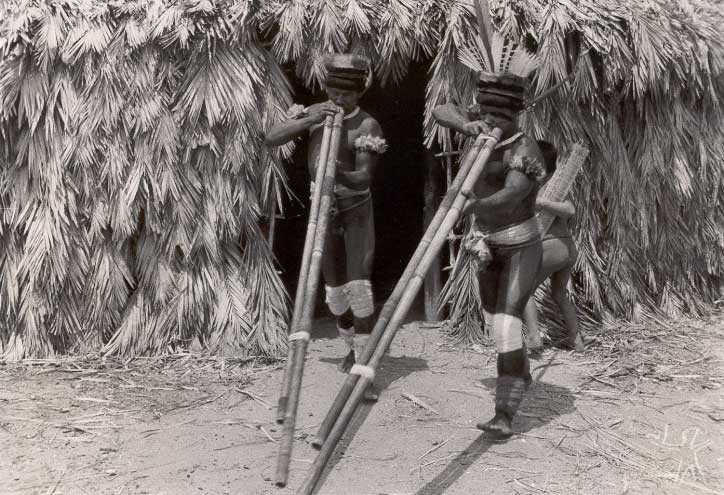
The Yamurikumalu ritual as well as the kagutu flutes suggest that it is above all through music that the differences and antagonisms between the sexes are emphasized. Yet, at the same time, the music effects communication between the performers of one sex and the listeners of the opposite sex, promoting a situation of control over those dangerous powers. Thus, in Kalapalo myth, music is treated as both the manifestation of aggressive transformations of powerful beings (itseke) and as a means available to people for controlling these forces.
In this way, the Kalapalo use music ritually as a means of communicating between what they define as insurmountably separated, or grossly unequal categories of beings: men and women; human beings and powerful beings; adults and small children. This communication takes place not so much by establishing a mood of sympathy as by demonstrating the power of these beings to listeners, using the latter’s powers to temporarily disarm them.
The most important ritual use of music occurs in public, collective events that take place for weeks and sometimes months at a time during the six-month dry season (isoa-) that falls between May and September. At the onset of this season, the Kalapalo are intensely occupied with these complex collective efforts that involve both a musical performances and economic activities.
Economic and ritual activities
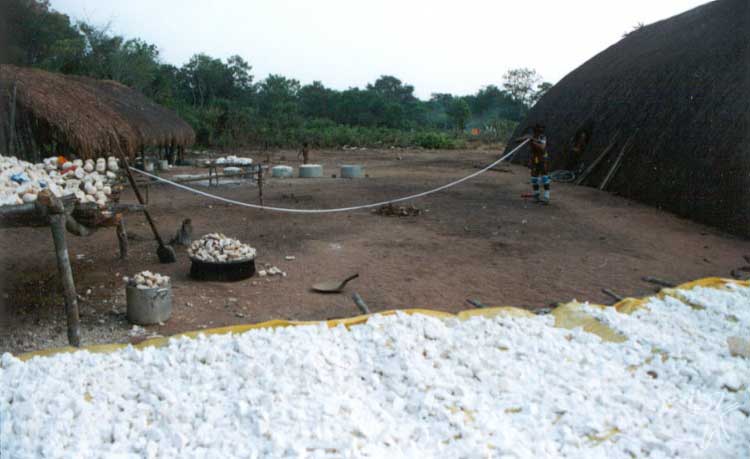
While the musical performances of a ritual are being held, parallel events are taking place, involving mainly economic activities. The community (called sandagi, “followers”) is led by special ritual officers who inherit their positions, known collectively as aneta~u, “leaders,” who plan, organize, and manage the ritual process. Roughly half of the population in the village receives this designation, including persons of both sexes and all ages, but only the oldest and most experienced consistently hold office.
Lesser tasks are generally allocated to younger anetaé when an event is sufficiently complex to warrant the use of more than two or three organizers. In the case of the egitsu rituals, when as many as five other settlements will be invited, each will be assigned a leader who serves as a messenger (t~iñ~i) and who is responsible for the well-being of the guests. He or she expects payment for this (normally in the form of shell ornaments or a large Waura pottery vessel) from the visiting group in question. In the context of these role enactments, the leaders are referred to as taiyope (“associated with conversation”) or tagioto (“conversation masters”).
As planners, ritual officers schedule and coordinate the entire series of public work projects: cleaning public spaces in the settlement, especially the central plaza, the formal entrance path, and the trail leading to the bathing place; arranging the tasks of collecting, processing, and distributing food, which will be used to repay the participants or to feed the guests later on; collecting raw materials, such as annatto, beeswax, shells, and burity palm for making costumes. These activities must be coordinated with the specific tasks associated with sending invitations to other settlements and preparing campgrounds outside the village to shelter the guests.
In ritual contexts, therefore, the scheduling and coordination of work involve relations between leaders and followers. In non-ritual contexts, Kalapalo social life tends to be organized around household groups and flexible networks of cognatic and affinal relatives. Insofar as Kalapalo ritual life takes up so much time and is directly correlated with major collective subsistence efforts, it is best thought of not so much in contrast with routine existence, but, rather, as a mode of constituting life that complements that of the non-ritual rainy season. What occurs is that the community’s social structure is ordered according to the seasons, such that, during the period of continuous, heavy rainfall, food is scarce and public performances are almost impossible, and, during the period of drought, food is abundant and diverse, and environmental conditions perfect for ceremonies within and between communities.
Intra and inter-community rituals
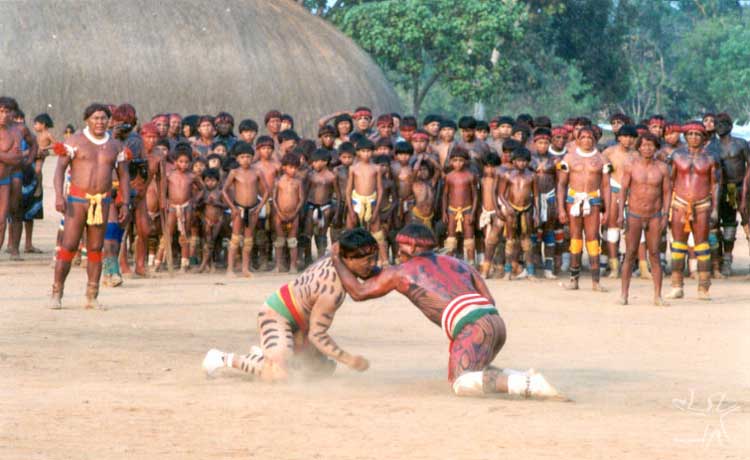
The Kalapalo classify their public rituals into two general types: egitsu (or, as it is more widely known, kwarup, a term from the neighboring Kamaiura and described in page Parque Indígena do Xingu, only in Portuguese version) and undufe. The word egitsu refers to events that involve the participating of guests from other Upper Xingu settlements. Included in this category are the egitsu proper, a ritual that commemorates deceased hereditary leaders (aneta~u); the ipoñe, or boys’ ear-piercing ritual; the women’s Yamurikmalu (or Yamurikumã in the Kamayura language) and men’s kagutu rituals; the katugakugu (referring to an object made of latex from a small rubber tree), which involves a ritual ball game; tawkaga, involving instruments of the same name; and, finally, ifagaka (more commonly known by the Kamayura term yawari), the spear-throwing ceremony.
All these events entail the repeated performance of music in the host community over a considerable period of time prior to the performance in which visitors participate. In addition, because egitsu rituals include athletic competition between guests and hosts, for several months prior to the appearance of the guests, the hosts practice their skills, just as the guests themselves are doing in their own settlements. In general, wrestling seems to be a way of temporarily diminishing, in a symbolic form, the social distance between people of different villages.
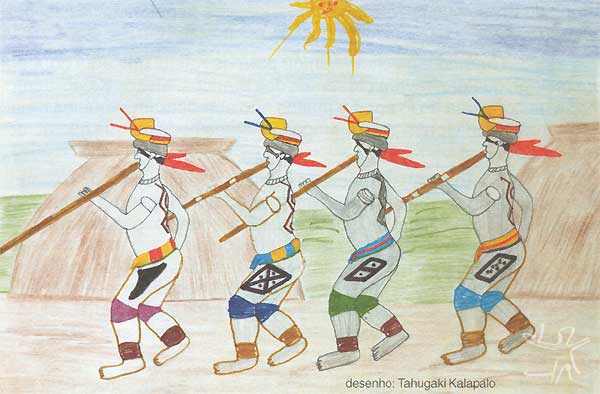
Among the rituals called undufe are performances that involve only the members of a particular settlement. These include the Kana undufegï, “Fishes’ undufe”; Eke undufegï, “Snakes’ undufe”; Fugey oto, “Arrow master ritual”; Agë, the manioc ritual held at the height of the harvest when the Pleiades become visible; Afugagï and others that involve the manufacture and use of masks associated with the itseke, the powerful beings who are the “masters” of the music; Kafugukuegï, “Howler monkey ritual”; Afasa, “Forest cannibal ritual”; Zhakwikatu, Kwambï, and Piju, “Powerful aquatic beings”; and Atugua, “Whirlwind undufe”.
Sources of information
- BASSO, Ellen B. La biografía de los Kalapalo como historia. In: --------; SHERZER, Joel (Coords.). Las culturas nativas latinoamericanas a traves de su discurso. Quito : Abya-Yala ; Roma : MLAL, 1990. p. 17-46. (Colección 500 Años, 24).
- --------. A história na mitologia : uma experiência dos Avoengos Calapalos com europeus. In: COELHO, Vera Penteado (Org.). Karl von den Steinen : um século de antropologia no Xingu. São Paulo : Edusp/Fapesp, 1993. p.311-46.
- --------. A husband for his daughter, a wife for her son : strategies for selecting a set of in-laws among the Kalapalo. In: KENSINGER, Kenneth M. (ed.). Marriage practices in lowland South America. Urbana : University of Illinois Press, 1984. p. 33-44.
- --------. Kalapalo biography : psychology and language in a South american oral history. American Anthropologist, Lancaster : American Anthropological Association, n. 91, p.551-69, 1989.
- --------. The Kalapalo indians of Central Brasil. New York : Holt, Rinehart and Winston, 1973.
- --------. A Kalapalo testimonial. L’Homme, Paris : École des Hautes Études en Sciences Soc., v. 33, n. 126/128, p. 379-407, abr./dez. 1993.
- --------. A musical view of the universe : Kalapalo myth and ritual performances. Filadélfia : Univ. of Pennsylvania Press, 1985. 359 p.
- --------. O que podemos aprender do discurso Kalapalo sobre a “história Kalapalo”? In: FRANCHETTO, Bruna; HECKENBERGER, Michael (Orgs.). Os povos do Alto Xingu : história e cultura. Rio de Janeiro : UFRJ, 2001. p.293-307.
- --------. The use of portuguese relationship terms in Kalapalo (Xingu Carib) enconunters : changes in a central Brazilian communication network. Language and Society, n.2, 1973.
- --------. Xingu Carib kinship terminology and marriage : another view. Southwestern Journal of Ant., Albuquerque : Univ. of New Mexico, v.26, n.4, p.402-16, 1970.
- GALVÃO, Eduardo. Diários do Xingu (1947-1967). In: GONÇALVES, Marco Antônio Teixeira (Org.). Diários de campo de Eduardo Galvão : Tenetehara, Kaioa e índios do Xingu. Rio de Janeiro : UFRJ, 1996. p. 249-381.
- HIEATT, Marcela Stockler Coelho de Souza. Faces da afinidade : um estudo do parentesco na etnografia xinguana. Rio de Janeiro : UFRJ-Museu Nacional, 1992. 154 p. (Dissertação de Mestrado)
- VILLAS BÔAS, Orlando. Encontro com os Kalapalo. In: --------. A vida de Orlando Villas Bôas : depoimento. Rio de Janeiro : Editora Rio, s.d.. p.29-34.
- WÜRKER, Estela (Org.). A saúde da nossa comunidade : povos Matipu, Kalapalo e Nahukua - Livro de Ciências-Saúde. São Paulo : ISA, 1999. 38 p.